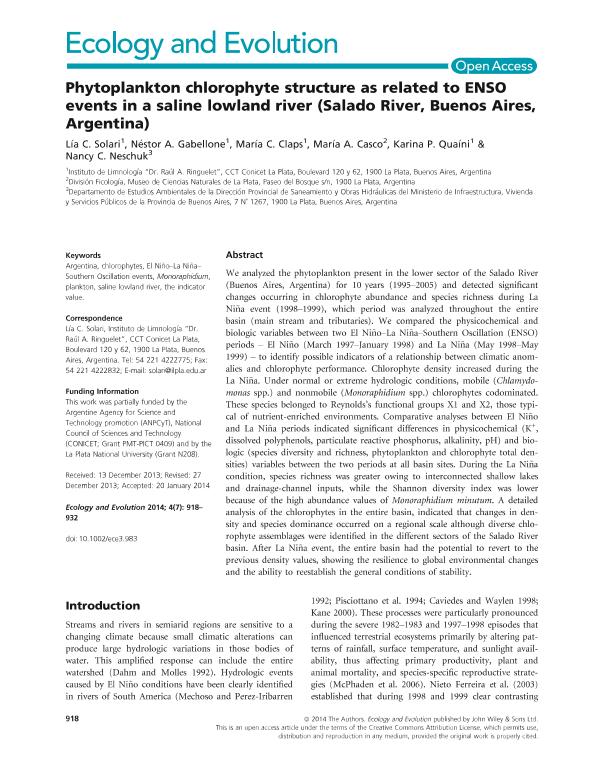Mostrar el registro sencillo del ítem
dc.contributor.author
Solari, Lía Cristina

dc.contributor.author
Gabellone, Nestor Adrian

dc.contributor.author
Claps, Maria Cristina

dc.contributor.author
Casco, Maria Adela

dc.contributor.author
Quaini, Karina Paola

dc.contributor.author
Neschuk, Nancy Carolina

dc.date.available
2017-08-11T18:40:50Z
dc.date.issued
2014-04
dc.identifier.citation
Solari, Lía Cristina; Gabellone, Nestor Adrian; Claps, Maria Cristina; Casco, Maria Adela; Quaini, Karina Paola; et al.; Phytoplankton chlorophyte structure as related to ENSO events in a saline lowland river (Salado River, Buenos Aires, Argentina); John Wiley & Sons Inc; Ecology and Evolution; 4; 7; 4-2014; 918-932
dc.identifier.issn
2045-7758
dc.identifier.uri
http://hdl.handle.net/11336/22221
dc.description.abstract
We analyzed the phytoplankton present in the lower sector of the Salado River (Buenos Aires, Argentina) for 10 years (1995–2005) and detected significant changes occurring in chlorophyte abundance and species richness during La Niña event (1998–1999), which period was analyzed throughout the entire basin (main stream and tributaries). We compared the physicochemical and biologic variables between two El Niño–La Niña–Southern Oscillation (ENSO) periods – El Niño (March 1997–January 1998) and La Niña (May 1998–May 1999) – to identify possible indicators of a relationship between climatic anomalies and chlorophyte performance. Chlorophyte density increased during the La Niña. Under normal or extreme hydrologic conditions, mobile (Chlamydomonas spp.) and nonmobile (Monoraphidium spp.) chlorophytes codominated. These species belonged to Reynolds's functional groups X1 and X2, those typical of nutrient-enriched environments. Comparative analyses between El Niño and La Niña periods indicated significant differences in physicochemical (K+, dissolved polyphenols, particulate reactive phosphorus, alkalinity, pH) and biologic (species diversity and richness, phytoplankton and chlorophyte total densities) variables between the two periods at all basin sites. During the La Niña condition, species richness was greater owing to interconnected shallow lakes and drainage-channel inputs, while the Shannon diversity index was lower because of the high abundance values of Monoraphidium minutum. A detailed analysis of the chlorophytes in the entire basin, indicated that changes in density and species dominance occurred on a regional scale although diverse chlorophyte assemblages were identified in the different sectors of the Salado River basin. After La Niña event, the entire basin had the potential to revert to the previous density values, showing the resilience to global environmental changes and the ability to reestablish the general conditions of stability.
dc.format
application/pdf
dc.language.iso
eng
dc.publisher
John Wiley & Sons Inc

dc.rights
info:eu-repo/semantics/openAccess
dc.rights.uri
https://creativecommons.org/licenses/by-nc-sa/2.5/ar/
dc.subject
ARGENTINA
dc.subject
CHLOROPHYTES
dc.subject
EL NIÑO-LA NIÑA-SOUTHERN OSCILLATION EVENTS
dc.subject
MONORAPHIDIUM
dc.subject
PLANKTON
dc.subject
SALINE LOWLAND RIVER
dc.subject
THE INDICATOR VALUE
dc.subject.classification
Oceanografía, Hidrología, Recursos Hídricos

dc.subject.classification
Ciencias de la Tierra y relacionadas con el Medio Ambiente

dc.subject.classification
CIENCIAS NATURALES Y EXACTAS

dc.title
Phytoplankton chlorophyte structure as related to ENSO events in a saline lowland river (Salado River, Buenos Aires, Argentina)
dc.type
info:eu-repo/semantics/article
dc.type
info:ar-repo/semantics/artículo
dc.type
info:eu-repo/semantics/publishedVersion
dc.date.updated
2017-05-02T18:17:39Z
dc.identifier.eissn
1852-2181
dc.journal.volume
4
dc.journal.number
7
dc.journal.pagination
918-932
dc.journal.pais
Reino Unido

dc.description.fil
Fil: Solari, Lía Cristina. Consejo Nacional de Investigaciones Científicas y Técnicas. Centro Científico Tecnológico Conicet - La Plata. Instituto de Limnología "Dr. Raúl A. Ringuelet". Universidad Nacional de La Plata. Facultad de Ciencias Naturales y Museo. Instituto de Limnología; Argentina
dc.description.fil
Fil: Gabellone, Nestor Adrian. Consejo Nacional de Investigaciones Científicas y Técnicas. Centro Científico Tecnológico Conicet - La Plata. Instituto de Limnología "Dr. Raúl A. Ringuelet". Universidad Nacional de La Plata. Facultad de Ciencias Naturales y Museo. Instituto de Limnología; Argentina
dc.description.fil
Fil: Claps, Maria Cristina. Consejo Nacional de Investigaciones Científicas y Técnicas. Centro Científico Tecnológico Conicet - La Plata. Instituto de Limnología "Dr. Raúl A. Ringuelet". Universidad Nacional de La Plata. Facultad de Ciencias Naturales y Museo. Instituto de Limnología; Argentina
dc.description.fil
Fil: Casco, Maria Adela. Universidad Nacional de la Plata. Facultad de Ciencias Naturales y Museo. Division Ficologia; Argentina. Consejo Nacional de Investigaciones Científicas y Técnicas; Argentina
dc.description.fil
Fil: Quaini, Karina Paola. Consejo Nacional de Investigaciones Científicas y Técnicas. Centro Científico Tecnológico Conicet - La Plata. Instituto de Limnología "Dr. Raúl A. Ringuelet". Universidad Nacional de La Plata. Facultad de Ciencias Naturales y Museo. Instituto de Limnología; Argentina
dc.description.fil
Fil: Neschuk, Nancy Carolina. Dirección Provincial de Saneamiento y Obras Hidráulicas del Ministerio de Infraestructura, Vivienda y Servicios Públicos de la Provincia de Buenos Aires; Argentina
dc.journal.title
Ecology and Evolution
dc.relation.alternativeid
info:eu-repo/semantics/altIdentifier/url/https://www.ncbi.nlm.nih.gov/pmc/articles/PMC3997310/
dc.relation.alternativeid
info:eu-repo/semantics/altIdentifier/doi/http://dx.doi.org/10.1002/ece3.983
dc.relation.alternativeid
info:eu-repo/semantics/altIdentifier/url/http://onlinelibrary.wiley.com/doi/10.1002/ece3.983/abstract
Archivos asociados
